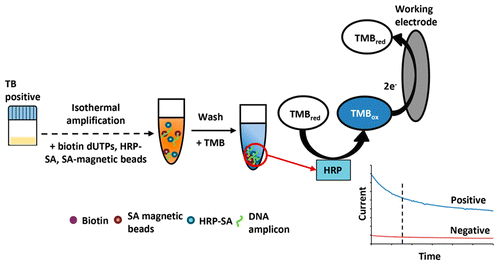Tuberculosis (TB) is a highly infectious disease and a major global health problem, especially in countries with developing health care systems. Because there is no fast, easy way to detect TB, the deadly infection can spread quickly through communities. Now, a team reports in ACS Sensors the development of a rapid, sensitive and low-cost method for detecting the disease in resource-limited areas.
The typical way that physicians screen for TB, which is caused by the bacterium Mycobacterium tuberculosis (Mtb), is with a tuberculin skin test or an examination of a patient's sputum under a microscope. To weed out false positives, a more reliable test that involves growing Mtb cultures can be performed, but that requires weeks to complete. For all of these methods, experienced personnel are needed. Another approach that is both quick and accurate is a nucleic acid amplification test, which makes many copies of the Mtb DNA in a sample. However, it is expensive and requires a lab setting. So, Matt Trau, Nicholas P. West and colleagues set out to create a simple, inexpensive and reliable way to quickly test for TB.
The researchers began with a newly created nucleic acid amplification test that does not require expensive lab equipment to detect Mtb. Still, this modified test typically uses costly fluorescence technology to read the results. So the team substituted the fluorescence detector with a colorimetric assay that changes to a blue hue if the infection is present, allowing health care workers to identify positive test results right away with the naked eye. They demonstrated how the modified diagnostic could be put on cheap, disposable electrochemical sensors for increased sensitivity, even in the field. Because the assay is inexpensive, quick and highly specific for the Mtb bacterium, the researchers say it could have a big impact in low-resource communities.
More information: Benjamin Y. C. Ng et al. Naked-Eye Colorimetric and Electrochemical Detection of —toward Rapid Screening for Active Case Finding , ACS Sensors (2015). DOI: 10.1021/acssensors.5b00171
Abstract
Despite recent advances in detection strategies, Tuberculosis (TB) is still a significant global health problem, partly due to a lack of rapid, sensitive, and low cost methodologies. In countries with developing health care systems, there is an urgent need to rapidly screen groups of people identified to have had contact with patients diagnosed with TB in order to halt the spread of the infection in their communities. To this end, we have devised a simple colorimetric assay that utilizes the chemical oxidation of 3,3′,5,5′-tetramethylbenzidine (TMB) by isothermally functionalized DNA targets as a sensitive and specific biosensor for the detection of Mycobacterium tuberculosis. As TMB is also electrochemically active, we extended the method to electrochemical detection on cheap disposable electrodes, and compared the characteristics of both sensing methods. Our assays are inexpensive (US$3), rapid (75 min), sensitive (approaching single cell), and highly specific to M. tuberculosis. We believe that our assay could potentially enable public health officials to quickly make important decisions related to the appropriate channeling of precious healthcare resources and form part of the solution to reduce lengthy time-to-diagnosis that is commonly associated with conventional approaches in these settings.
Provided by American Chemical Society




















